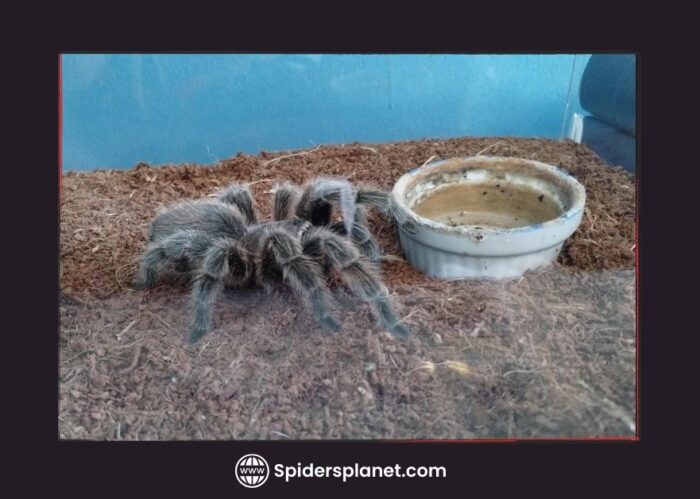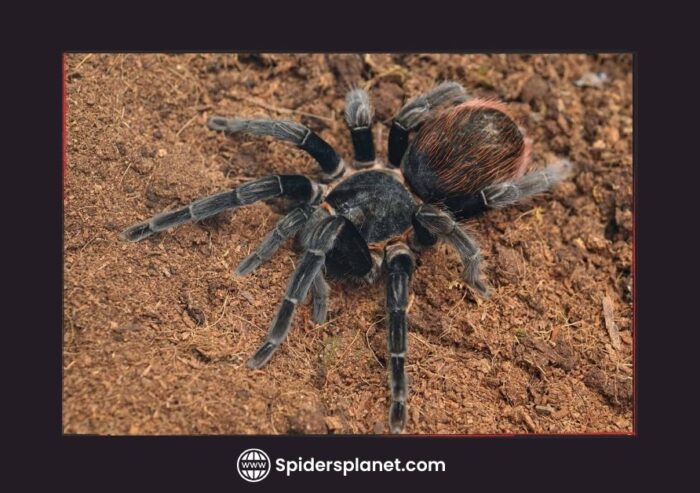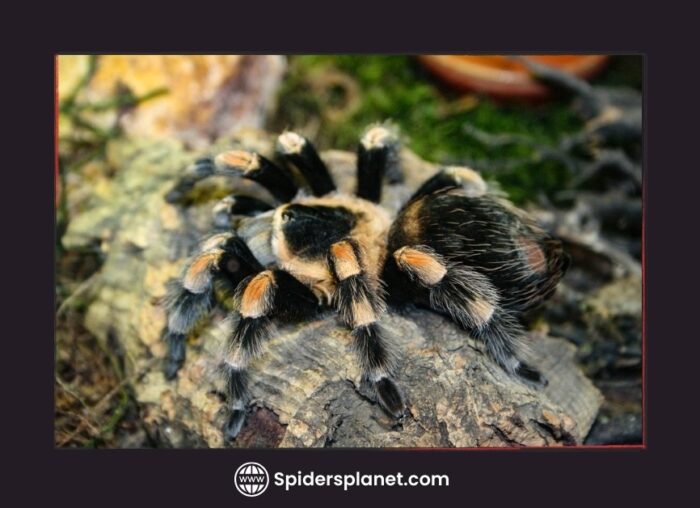Ever seen your spider hunting a cricket in its home? It is quite a sight! But sometimes, things get a bit worrying when your spider stays still and won’t eat.
You start wondering, “Why isn’t my spider eating?” keeps repeating in the minds of spider lovers.
No need to worry; this article is here to explain why your tarantula might suddenly stop eating. We will look at different reasons, like when they are getting ready to molt or if something in their environment is bothering them.
We will give you all the information you need to figure out and fix why your spider is being picky about food. It’s time to help your furry friend start enjoying meals again!
What Do Tarantulas Eat?
Tarantulas, as carnivores, have a diverse menu influenced by their species, size, and habitat.
Their primary diet comprises insects like crickets, roaches, beetles, grasshoppers, and worms, with larger tarantulas capable of tackling more substantial prey such as locusts and cicadas.
Some tarantulas exhibit cannibalistic tendencies, snacking on smaller spiders nearby, while others, like the Goliath Birdeater, may consume small vertebrates like lizards, frogs, snakes, and even rodents.
Certain tarantulas enjoy bird eggs; some may accept fish if offered. Here is the list of food tarantulas enjoy to have:
- Grasshoppers
- Crickets
- Beetles
- Smaller spiders
- Arthropods
- Cicadas
- Caterpillars
- Millipedes
- Mealworms
- Superworms
- Roaches
- King worms
- Silkworms
- Hornworms
- Toads
- Frogs
- Fish
- Lizards
- Bats
- Pinky mice
- Rodents
- Small snake
- Birds
It is essential to provide appropriately sized prey, maintain variety for a balanced diet, prioritize freshness in offerings, and leave uneaten food briefly, removing it after 24 hours to prevent mold and bacteria issues.
What Do Tarantulas Eat in Captivity?
When kept as pets in cages, these marvels are still carnivores. Tarantula keepers commonly offer a variety of appropriately sized insects, such as crickets, roaches, locusts, grasshoppers, beetles, and worms.
More experienced keepers may introduce smaller spiders as prey for larger tarantulas.
In contrast, larger species like the Goliath Birdeater might enjoy occasional treats like pinky mice, frogs, lizards, and small snakes.

Side dishes may include rare delicacies like bird eggs for certain tarantulas.
It is crucial to maintain variety for a balanced diet, ensure freshness with live or pre-killed prey, and practice portion control based on the tarantula’s abdomen size.
Promptly remove uneaten food within 24 hours and consider species-specific needs, such as extended fasting for some new world species.
Feeding tips, like using gut-loaded insects and placing food strategically for nocturnal species, further contribute to the well-being of your eight-legged companion.
Regular observation and consultation with a veterinarian or experienced keeper help address any concerns about your tarantula’s appetite or overall health, ensuring a nutritious and diverse diet for a happy and healthy life.
How often do Tarantulas need to Eat?
Various factors influence the feeding frequency of your tarantula:
Age is one of the factors. For slings (baby tarantulas), provide food 2-4 times a week, with prey items half their size.
Juveniles should be fed once every 4-7 days, with prey items equal to or slightly smaller than their abdomen. Adults generally require feeding once every 7-10 days, with prey items not exceeding the size of their abdomen.
Different species have varying feeding patterns; for instance, some, like New World tarantulas, may go without eating for months.
Researching and understanding the unique requirements of your tarantula’s species is essential for providing optimal care and ensuring its well-being.
Tarantulas typically stop eating 1 to 2 weeks before molting and may not resume eating for a few days afterward.
A healthy, active tarantula tends to eat more than an unwell or inactive one.
Why Is My Tarantula Not Eating?
Several reasons could explain why your tarantula is not eating, and many of them are typically not cause for immediate concern.
Here are some of the most common explanations:
Molting Can be the Reason:
Understanding why your tarantula is not eating requires insight into their extraordinary lifecycle, particularly the molting process.
This significant transformation is pivotal for their growth and well-being, significantly influencing their eating habits.
Pre-Molt Fasting:
Before a molt, tarantulas undergo a crucial period of pre-molt fasting, lasting one to two weeks.
This is not a mere hunger strike; it is a strategic investment in their imminent transformation. Energy conservation is a key aspect, as tarantulas avoid digestion to preserve energy for producing a new exoskeleton.
Fasting provides flexibility and space for shedding the old skin and forming the new exoskeleton.
By minimizing waste inside the old exoskeleton, tarantulas optimize the molting process. If your tarantula exhibits a plump abdomen and refrains from eating, they might be entering the pre-molt phase.
There is no cause for panic; observe their behavior without offering food, as this is a natural and necessary step in their life cycle.
Post-Molt Recovery:
After shedding their old exoskeleton, tarantulas enter a delicate post-molt recovery phase.
Their new skin is soft, and internal adjustments take time, naturally suppressing their appetite. Consider it akin to recovering from a strenuous physical feat.
During post-molt recovery, tarantulas may appear less active, prioritizing energy for internal recovery.
Expect a subdued appetite for a few days to a week, as premature feeding can be stressful.
Handle with care during this time, as the new skin is vulnerable, and gentle observation is advisable.
Patience is key during post-molt recovery. Create a calm environment, avoid force-feeding, and observe signs of recovery, like increased activity and hardening of the new exoskeleton.
Once ready, introduce a small prey item gradually. Understanding these phases allows you to approach their temporary loss of appetite with confidence, knowing it is a natural and vital aspect of their growth and well-being.
Fasting Can be the Reason:
Sometimes, tarantulas take a break from eating, and this is okay. It is a natural thing for them, especially some kinds like Brachypelmas and Aphonopelmas.
These tarantulas can go without food for a long time because they have a good way of saving energy.
Unlike animals we know, tarantulas do not need to eat a lot. After a good meal, they can be okay for a while.
Changes in their home, like moving things around or making it too hot or cold, might make them not want to eat for a bit.
If your tarantula is not eating but still looks healthy and active, it is probably just taking a break.
Keep an eye on it, and if it goes on for a really long time or it seems sick, it is a good idea to ask someone who knows a lot about tarantulas, like a vet or someone experienced with them.
Remember, it is a normal part of how tarantulas live, and they will start eating again when they are ready.
Related Post: Do Spiders Fart? Top 6 Facts You Need to Know
Environmental Factors Can be the Reason:
While a tarantula’s pre-molt fasting and natural cycles are essential, the environment they live in also plays a surprising role in their eating habits.

Factors like temperature and humidity can significantly impact your tarantula’s willingness to eat.
Let’s explore these environmental aspects and understand how they affect your furry friend’s appetite:
Temperature:
Tarantulas, being cold-blooded, rely on their environment to regulate internal temperature and metabolism. Extremes in temperature can influence their appetite:
Hot temperatures can make tarantulas sluggish, slowing down their metabolism. It can reduce their interest in food as consuming meals becomes less appealing in the heat.
Cold temperature can also suppress appetite, as the tarantula’s metabolism slows down, making digestion sluggish. They might conserve energy by skipping meals until a more comfortable temperature is restored.
Humidity:
Humidity is crucial for a tarantula’s well-being, impacting various aspects of their health, including appetite:
Low humidity can cause discomfort and stress, leading to a lack of interest in food as the tarantula’s external body dries out.
Excessive humidity poses risks like mold growth and difficulty breathing, negatively impacting appetite due to discomfort.
Corrective Measures:
Suspecting temperature or humidity issues, take corrective action:
- Achieving the right temperature and humidity depends on your tarantula’s species and natural habitat. Generally, aim for a temperature of 70-80°F (21-27°C) and humidity between 60-80%.
- Adjust temperature, use heating pads, or adjust the thermostat for the desired range.
- Manage humidity, lightly mist, or use a humidifier to increase humidity levels.
- Monitor conditions; invest in a hygrometer and thermometer for accurate environmental monitoring.
- Prioritizing health over force feeding by maintaining the right temperature and humidity creates a comfortable environment, supporting proper metabolism and encouraging a natural return of appetite.
Stress Can be the Reason:
Most tarantulas are solitary by nature, adapted to living and hunting alone. Sharing an enclosure, even with seemingly harmless companions, can stress them out and impact their desire to eat.
This territorial stress shows signs like loss of appetite, increased hiding, and defensive behaviors.
When a tarantula feels threatened, it might withdraw or display defensive postures.
To reduce this stress, it is crucial to provide a solitary living space and create an environment with hiding spots.
Avoid unnecessary disturbances and, if needed, introduce tank mates carefully.
By understanding and addressing territorial stress, you create a calm space for your tarantula, regulating their metabolism and encouraging a natural return of appetite.
Remember, patience is key, and forcing them to eat can make things worse.
Seasonal Changes influence Tarantula’s Appetite:
Just like us, tarantulas can be affected by changes in seasons. When it gets cooler in fall and winter, tarantulas naturally slow down. Their bodies do not need as much energy, so they eat less.
You might notice your tarantula being less interested in food, taking longer to approach prey, and eating less often.

Also, shorter days in winter can make them less active because they use light cues for hunting. Some tarantulas molt more in warmer months, but some do it even in winter.
During molting, they might not eat as they focus on changing their exoskeleton. Here’s what you can do:
In colder months, it is normal for tarantulas to eat less. Watch for unusual behaviors, adjust feeding to every two weeks or monthly, choose smaller prey, and maintain proper temperature and humidity.
Each tarantula is unique, so consult a vet or expert if worried. Understanding seasonal changes helps keep your tarantula healthy year-round.
Dietary Preferences Can be the Reason:
Dietary preferences and variety are key factors in your tarantula’s appetite, especially when they are not eating well in colder months. Consider the following:
- If your tarantula is new, it may still be adjusting to its diet. Try offering familiar prey and gradually introducing new options.
- Ensure a balanced diet with variety to prevent nutritional deficiencies. Extended periods of the same prey may lead to a decreased appetite.
- Choose prey appropriate for your tarantula’s size and species. Experiment with different types to find their preferences.
- Some tarantulas prefer hunting. Offer live prey cautiously to see if it boosts their appetite.
- Provide fresh and healthy prey. Poorly kept prey can be unappealing and lack nutritional value.
Diversify their diet with the following:
- Different insect species (crickets, roaches, worms, locusts).
- Occasional variety with protein sources like pinky mice (for larger species).
- Dusting prey with insectivore-specific supplements.
By offering diverse, high-quality prey and adjusting feeding based on individual preferences and seasons, you can encourage your tarantula to maintain a healthy appetite throughout the year.
Your Tarantula is Sick: Can be the Reason:
Understanding the reasons behind your tarantula’s reluctance to eat is crucial for ensuring their health, and potential issues such as parasites, infections, and dental problems should be considered.
Internal parasites like worms can cause weight loss, while external parasites like mites may induce discomfort.
Infections, whether bacterial or fungal, can affect internal organs or the exoskeleton, leading to pain and loss of appetite.
Dental problems, though less common, such as malocclusion or damaged mouthparts, can also hinder the feeding process.
Monitoring signs like lethargy, abnormal appearance, or difficulty grasping prey is essential.
Immediate consultation with a vet, maintaining proper hygiene, and adapting prey options are crucial steps for addressing these concerns.
Also Read: Orange Spiders (Araneus Marmoreus): Behavior, Lifecycle & Facts
What to do if my tarantula is not Eating?
- Avoid forcing your tarantula to eat; if they reject a meal, remove the prey after 24 hours and try again later. Maybe your tarantula does not want to eat, or he is full.
- Monitor your tarantula’s abdomen size; excessive plumpness may indicate overfeeding. Adapt feeding practices to promote the overall health and happiness of your eight-legged companion in accordance with its specific needs.
- Establishing an ideal environment for your tarantula is pivotal for its overall well-being and appetite, especially in colder months when their metabolism slows down. Proper enclosure conditions significantly influence their eating habits.
- Maintaining specific temperature and humidity levels tailored to their species is vital, using tools like heat mats or humidifiers.
- The substrate and enrichment items in their enclosure should cater to their needs, offering burrowing options or climbing opportunities.
- Establishing a day/night cycle with appropriate lighting and minimizing disturbance during handling fosters a stress-free environment.
Some Bonus Tips:
- Regular cleaning and hygiene practices, including waste removal, prevent health issues that could impact appetite.
- Some tarantulas may be enticed by prey scented with familiar smells or dipped in substances like honey or bee pollen (avoid artificial scents).
- If your tarantula is hesitant to hunt live prey, try pre-killing by freezing or humane euthanasia. Be aware that some tarantulas lose interest due to the lack of movement.
- Place prey items in different areas, including hides and caves, to cater to your tarantula’s preferred hunting style.
- Experiment with offering food at different times of the day or night.
- A brief fast of a few days can stimulate appetite, but avoid prolonged fasting, especially for slings or smaller species.
- Always consult a vet or experienced tarantula keeper before attempting specialized techniques.
- Be patient, allowing time for your tarantula to adjust or regain its appetite.
- Prioritize your tarantula’s well-being, avoiding excessive attempts to feed.
Researching your tarantula’s species-specific requirements and following additional tips, such as avoiding drafty areas, ensures a comfortable and stimulating habitat.
By prioritizing a happy and healthy environment, you can encourage your tarantula to maintain a robust appetite, even during the colder months.
Final Thoughts:
Understanding the nuances of your tarantula’s eating habits is crucial for their well-being.
This article has provided comprehensive insights into the reasons behind a tarantula’s reluctance to eat, covering factors such as molting phases, environmental influences, health issues, and dietary preferences.
It emphasized the significance of creating an optimal living environment, adapting feeding strategies, and seeking prompt veterinary advice when needed.
By prioritizing the specific needs of individual tarantulas, keepers can ensure a balanced diet, minimize stressors, and foster a healthy appetite, contributing to the overall thriving of these captivating arachnids.
FAQs:
How long can tarantulas go without eating?
They might be having an eating gap of months, highlighting their slow metabolism and allowing for extended periods of fasting.
Who eats tarantulas?
Predators are birds, snakes, wasps, and even other hungry tarantulas.
Do tarantulas eat humans?
Tarantulas won’t consider humans as prey. Humans are far too big for even the largest tarantula.
Why is my tarantula not eating after molting?
“Post-molting fast” is explained as a normal process, as they rebuild their exoskeleton and rest their digestive system.
How long can a pet tarantula go without eating?
Depends on species, age, and environment. A week or two is typical.
Why did the tarantula not eat the frog?
It may be size, freshness, or lack of movement. Try smaller, livelier prey.
Why do Tarantulas not eat for months?
Remember, not eating for months is perfectly normal for tarantulas as long as they appear healthy and have access to water.
However, if your tarantula stops eating for an unusually long time or exhibits other concerning behaviors, it is best to consult an experienced vet or tarantula keeper.




Leave a Reply